
Introduction
- Simply stating, Urban Heat Island (UHI) is defined as drastic increase of urban temperature compared to their rural surroundings.
- It is a metropolitan area whose temperature is significantly warmer/hot compared to its surrounding areas
- Moreover, the name itself implies that it is a condition where the urban area turns to a heat island due to different factors
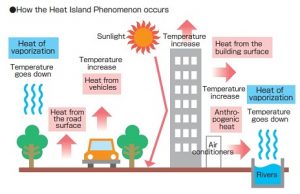
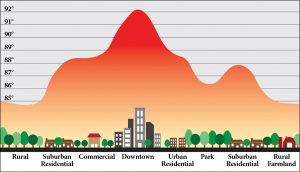
- This concept of UHI can be considered as one of the most unambiguous and flawless example of climate change due to anthropogenic sources
- It is estimated that approximately three billion people in the world are suffering from the consequences of UHI every day and this number is going to increase significantly in the coming days
Variation in magnitude of Urban Heat Island (UHI)
- The magnitude of UHI varies as per the time and season
- Hotness is more in the urban areas after 3-4 hours of sunset and during the monsoon period. However, discrepancy can be seen even in the urban areas as those areas which have more green space and less anthropogenic heat are less hot compared to those areas with lesser green spaces and more anthropogenic heat.
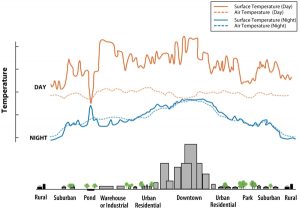
- The annual mean air temperature of a city with 1 million people or more can be 1.8–5.4°F (1–3°C) warmer than its surroundings
- Temperature difference in urban heat island is larger at night than during the day and larger in winter than in summer days
Some major factors contributing to Urban Heat Island
- Physical properties of building materials, building geometry and design
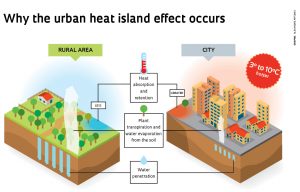
- Increased and uncontrolled industrialization
- Anthropogenic heat sources
- Decreased Evo transpiration
- High population
- Urban cityscape
- Energy consumption and lifestyle
- Enormous production of energy from sources like industry, vehicles and houses
- Built environment and concrete buildings as building materials are good insulators and can hold more heat
Impacts/effects of Urban Heat Island
Health Effects:
- Emergence of infectious diseases
- Extensive heat causing dehydration, heat exhaustion and heat syncope
- Respiratory difficulties, heat cramps and heat related mortality
- Circulatory and cerebrovascular effects like heat exhaustion, heat collapse and heat stroke
- Increase in morbidity and fatality, especially for those working in outdoor conditions
Other effects:
- Reduced labor capacity (Water loss of 1–2% of body weight can reduce labor capacity by 6–7%)
- Reduced productivity
- Lower air quality as pollutants produced from vehicles, industries and people are trapped by the urban landscape
- Change in weather and climatic conditions
- Depleted water quality
- Increased energy demand and consumption due to high demand of Air conditioners and fans
- Amplified emission of air pollutants and greenhouse gases
- Alter in ecosystem affecting the lives of animals and plants
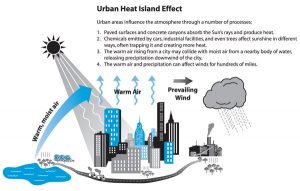
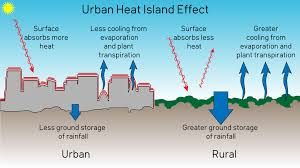
Strategies to decrease Urban Heat Island
- Use of light colored roofs and walls
- Afforestation and plantation in city areas
- Rooftop farming and agriculture
- Green parking lots
- Implementation of heat reduction strategies
- Lesser use of vehicles
- Car pooling
- Promotion of greener lands and parks in urban areas
- Grassy lands promotion
- Eco-roofing
References and for more information:
https://www.nationalgeographic.org/encyclopedia/urban-heat-island/
https://www.epa.gov/heat-islands/learn-about-heat-islands
https://www.epa.gov/heat-islands/heat-island-impacts
https://scied.ucar.edu/longcontent/urban-heat-islands
https://science.howstuffworks.com/environmental/green-science/urban-heat-island.htm
https://www.conserve-energy-future.com/effects-solutions-urban-heat-island.php
http://thegreencity.com/the-causes-and-effects-of-the-urban-heat-island-effect/
https://www.skepticalscience.com/urban-heat-island-effect.htm
https://www.nature.com/articles/s41598-017-04242-2
https://www.ncbi.nlm.nih.gov/pubmed/19727842
https://www.sciencedirect.com/science/article/pii/S2210670715000657
https://www.epa.gov/heat-islands
https://www.epa.gov/sites/production/files/2014-06/documents/basicscompendium.pdf
https://www.sciencedirect.com/science/article/pii/S2212095514001126
http://www.gardinergreenribbon.com/heat-island-effect/
https://www.hindawi.com/journals/amete/2010/230365/
https://climatekids.nasa.gov/heat-islands/
Allex, B., Arnberger, A., Wanka, A., Eder, R., Hitter, P. Kundi, M., Wallner, P., Kolland, F & Grew, H. 2013.The Elderly under Urban Heat Pressure – Strategies and Behaviours of Elderly Residents against UrbanHeat.REAL CORP 909-915.
Arnfield, A. J. (2003). Two decades of urban climate research: a review of turbulence, exchanges of energy and water, and the urban heat island. International journal of climatology, 23(1), 1-26.
Basu, R. (2009). High ambient temperature and mortality: a review of epidemiologic studies from 2001 to 2008. Environmental Health, 8(1), 1.
Biswas, R., Samanta, A., Saha, P. 2011. Cardiac Strain of Confectionery Worker in Relation to Heat Exposure DuringRegular Work Shift. Indian Journal of Occupational and Environmental Medicine 15: 3, 120–6.
Böhm, R. (1998). Urban bias in temperature time series – A case study for the city of Vienna,
Austria. Climatic Change 38, pp. 113–128.
Borden, Kevin, & Cutter, Susan. (2008). Spatial patternsof natural hazards mortality in the United States.International Journal of Health Geographics, 7(1), 64.
Brazdil, R., Pfister, C., Wanner, H., Von.,Storch, H., Luterbarcher, J. (2005) Historical Climatology in Europ-the state of art. Climatic Changes, 70(3):363-430.
Chow, W. T., & Roth, M. (2006). Temporal dynamics of the urban heat island of Singapore. International Journal of climatology, 26(15), 2243-2260.
Cortez, O.D. 2009.Heat stress assessment among workers in a Nicaraguan sugarcane farm.Global Health Action.
Dunne, John P., Stouffer, Ronald J., & John, Jasmin G.(2013). Reductions in labour capacity from heat stressunder climate warming. Nature Clim. Change, 3(6),563-566. doi: 10.1038/nclimate1827
Ebi, K.L., Schmier, J.K. 2005. A stitch in time: improving public health early warning systems for extreme weather events.Epidemiol Review 27, 115–121.
Hanna, E.G., Kjellström, T., Bennett, C., and Dear, K. 2011. Climate change and rising heat: population healthimplications for working people in Australia. Asia-Pacific Journal of Public Health 23: 2.
Hasan, A. S. U., & Rahman, M. Z. (2013). Change in temperature over Bangladesh associated with degrees of global warming. Asian Journal of Applied Science and Engineering, 2(2), 161-174.
Hoa, D., Nguyet, D., Phuong, N., Nga, V., Few, R., &Winkels, A. 2013. Heat stress and adaptive capacity of low-income outdoor workers and theirfamilies in the city of Da Nang, Vietnam, Asian Cities Climate Resilience.
Huang, C., Barnett, A. G., Xu, Z., Chu, C., Wang, X., Turner, L. R., & Tong, S. (2013). Managing the health effects of temperature in response to climate change: challenges ahead. Environmental Health Perspectives (Online), 121(4), 415.
Huang, Cunrui, Barnett, Adrian G., Wang, Xiaoming, &Tong, Shilu. (2012). The impact of temperature on yearsof life lost in Brisbane, Australia. Nature Clim. Change,2(4), 265- 270
Islam, A. S. (2009). Analyzing changes of temperature over Bangladesh due to global warming using historic data. Young Scientists of Asia Conclave, Jawaharlal Nehru Centre for Advanced Scientific Research (JNCASR), 15-17.
Islands, E. R. U. H. (2011). Compendium of strategies. Urban Heat Island Basics, 1-22.
Jabeen, H., Johnson, C., & Allen, A. (2010). Built-in resilience: learning from grassroots coping strategies for climate variability. Environment and Urbanization, 22(2), 415-431.
Kjellström, T, Gabrysch, S., Lemke, B. and Dear, K. 2009a. The ‘Hothaps’ programme for assessing climate changeimpacts on occupational health and productivity: an invitation to carry out field studies. Global Health Action.
Kjellstrom, T., Kovats, R. Sari, Lloyd, Simon J., Holt,Tom, &Tol, Richard S. J. (2009b). The Direct Impactof Climate Change on Regional Labor Productivity.Archives of Environmental & Occupational Health, 64(4),217-227. doi:10.1080/19338240903352776
Kovats, R. S., &Hajat, S. (2008). Heat stress and public health: a critical review. Annu. Rev. Public Health, 29, 41-55.
Langkulsen, U, Vichit-Vadakan, N. and Taptagaporn, S. 2010. Health impact of climate change on occupational health andproductivity in Thailand. Global Health Action 3: 5607.
Lin, R.T. and Chan, C.C. 2009.Effects of heat on workers’ health and productivity in Taiwan.Global Health Action.
Mather JR. Climatology: fundamentals and aplications. United States of America: McGraw-Hill Inc; 1974.
Nainate, A. and Chaunchaiyakul, R. 2006. Cardio-respiratory responses during continuous exercise under heat stress insedentary subjects. Journal of Sports Science and Technology, Thailand. 6, 33–47.
O’Neill, M. S., &Ebi, K. L. (2009). Temperature extremes and health: impacts of climate variability and change in the United States. Journal of Occupational and Environmental Medicine, 51(1), 13-25.
Oke, T. R. (1987). Boundary layer climates. London: Routledge.
Parsons, K. (2003). Human thermal environment. The effects of hot, moderate and cold temperatures on human health, comfort and performance.
Patz, J. A., and Olson, S. H. (2006). Climate change and health: global to local influences on
disease risk. Annals of Tropical Medicine & Parasitology 100, pp. 535–549.
Rizwan, A. M., Dennis, L. Y., &Chunho, L. I. U. (2008). A review on the generation, determination and mitigation of Urban Heat Island. Journal of Environmental Sciences, 20(1), 120-128.
Roth, M. 2012. Handbook of Environmental Fluid Dynamics, Systems, Pollution, Modeling, and Measurements, Urban Heat Islands,2: 143-158
Roy, S. C., Asaduzzaman, M., &Jahan, I. (2001). Urbanization and Microclimatic Change of Dhaka City.
Rushayati, S. B., Prasetyo, L. B., Puspaningsih, N., &Rachmawati, E. (2016). Adaptation strategy toward urban heat island at tropical urban area. Procedia Environmental Sciences, 33, 221-229.
Ryu, Y. H., &Baik, J. J. (2012). Quantitative analysis of factors contributing to urban heat island intensity. Journal of Applied Meteorology and Climatology. 51(5), 842-854.
Salamanca, F., Georgescu, M., Mahalov, A., Moustaoui, M., & Wang, M. (2014). Anthropogenic heating of the urban environment due to air conditioning. Journal of Geophysical Research: Atmospheres, 119(10), 5949-5965.
Salleh, S. A., Latif, Z. A., Mohd, W. M. N. W.,&Chan, A. (2013). Factors Contributing to the Formation of an Urban HeatIsland in Putrajaya, Malaysia. Procedia-Social and Behavioral Sciences, 105, 840-850
SERIES, S. (2013). Temperature Impacts on Health, Productivity, and Infrastructure in the Urban Setting, and Options for Adaptation. Institute for Social and Environmental Transition-International, 1.
Vaneckova, P., Hart, M. A., Beggs, P. J., & de Dear, R. J. (2008). Synoptic analysis of heat- related mortality in Sydney, Australia, 1993–2001. International journal of biometeorology, 52(6), 439-451.
Weng Q, Yang S. Managing the adverse thermal effects of urban development in a densely populated Chinese city. J Env Man 2004;70:145-56
World Health Organization. (2003). Climate change and human health: risks and response summary